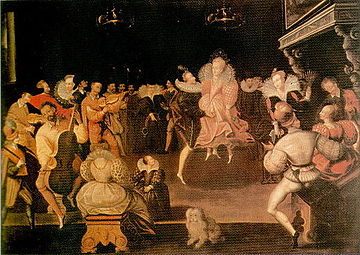
Back لا فولتا Arabic Volta (Tanz) German Volta (danza) Spanish لاولتا Persian Volta (tanssi) Finnish Volte French Volta (danza) Italian Volta (dans) NB Вольта (танец) Russian Volta (dans) Swedish
This article needs additional citations for verification. (August 2008) |

The volta (plural: voltas) (Italian: "the turn" or "turning") is an anglicised name for a dance for couples that was popular during the later Renaissance period. This dance was associated with the galliard[1] and done to the same kind of music. Its main figure consisted of a turn and lift in a sort of closed position, which could be done either to the right or to the left. It is also called La volta, Volta, Volte. Spelling variants include la volta and levolto; its name is la volte in French and la volta in Italian. It was considered at first to be risque and controversial.[1] Although the dance was known at the court of Elizabeth I, the popular notion (much portrayed in film and television) that Elizabeth and her favourite Lord Robert Dudley regularly performed the volta has been repudiated.[2]
- ^ a b Kassing, Gayle (2007). History of Dance: An Interactive Arts Approach. Human Kinetics. p. 82. ISBN 978-0736060356. Retrieved February 19, 2015.
- ^ Ian Pittaway "The scandalous la volta". 3 December 2018.
© MMXXIII Rich X Search. We shall prevail. All rights reserved. Rich X Search